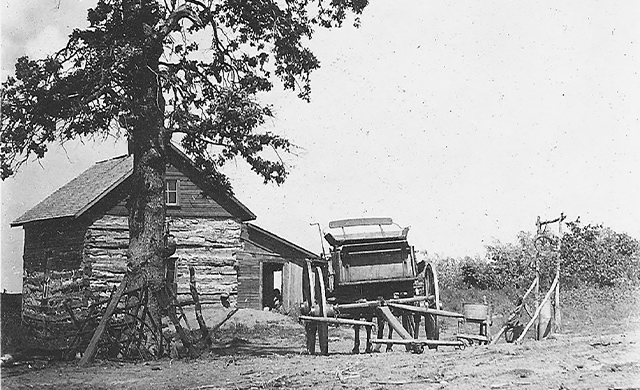Half Prairie, Half Forest

When 1889 homesteaders arrived in the area presently known as Oklahoma City and Edmond, the landscape looked quite different. The western portion was a stark, flat grassland. The eastern part was a belt of ancient deciduous forest.
Several geological features caused this “prairie by the forest.” First, a dry ancient riverbed left behind sandstone ridges that only certain trees and prairie grasses can tolerate. Second, central Oklahoma is in the “rain shadow” of the Rocky Mountains. Dry air travels across the plains, but by the time it reaches eastern Oklahoma, the air has gathered moisture again and is ready to rain—which explains why eastern Oklahoma has more lakes and trees.
Pioneers on the Prairie
The severe contrast between the plains and forest was more evident back before folks planted trees to shade the prairie and prevent future dust bowls.
“Early pioneers trekking west viewed the Great Plains as the ‘American Desert,’ because it was flat and lacked trees,” explained Neil Garrison, naturalist. “It’s actually part of the mixed-grass prairie.”
The mixed-grass prairie is a specific ecosystem; one that used to sustain bison and one that still provides important pollinator insects. It’s a shame more people don’t embrace native plants that have always grown here,” said Garrison. “There’s new research that native switch grass is potentially a vehicle fuel. With perennial roots, farmers just harvest the top growth each year, and it doesn’t need a lot of attention.”
Timber!
To the east of I-35, there runs a thick belt of gnarled trees that cut a line through Oklahoma, It’s called the Cross Timbers. To understand the name Cross Timbers, imagine early settlers trying to cross through a thick barrier of trees in a covered wagon.
“It was daunting. Here’s a forest that would tear at your clothing, scratch at your skin, and snag everything. You can’t bend these trees over or break them. It was really difficult for pioneers to get through with an ax,” said Garrison.
Ironically, few early photographs of the Cross Timbers exist, because this forest was seen as troublesome, not beautiful. Its predominate species, blackjacks and post oaks, have twisted, spooky-looking branches. At only 30 feet tall, these short trees wind their branches together to form an impenetrable canopy. Add vine growth, and the forest becomes a tangled darkness. Even archeological evidence suggests that native American tribes only traveled through, but didn’t live, in the Cross Timbers.
“It’s no accident that I-35 is where it is,” said Garrison. “No one wanted to plow through the middle of the Cross Timbers, so the thoroughfare was built along the western edge.”
The Oldest Trees
It is along I-35 that researchers find evidence of the oldest trees. Biology professor, Chad King, has studied Edmond trees for five years. “I’ve yet to find a good, old photo evidencing the Cross Timbers of Edmond. The photosa re almost entirely of grasslands, without a tree in sight–but tree dating proves these trees existed and when they’ve been planted since,” King said. “We’ve aged over 500 trees, and so far, the oldest ones are around Lake Arcadia. The oldest is a post oak from the early 1800s, but Hafer Park andMitch Park also have old-growth trees dating to the mid-1800s.”
Further south, forestry officials recently identified a bur oak at the Oklahoma City Zoo to be 150-200 years old. The zoo, also situated along the Cross Timbers, recently planted 1,000 oak seedlings on property so that oaks would remain part of the landscape for hundreds more years.
Today’s Landscape
In the last 130 years, the natural features of the prairie and Cross Timbers have changed due to urbanization. Professionals who study the local landscape are researching plant heritage in order to help landowners make sustainable choices to keep the ecoregion healthy in the future.
Leigh Martin, a tree expert with Edmond Urban Forestry, raises awareness about how to best care for Oklahoma trees. “Undisturbed trees in the Cross Timbers are resilient, because they are adapted to dry soils. In the urban landscape, fescue lawns and frequent irrigation can stress the trees. Some oaks are hard to transplant or difficult to find at nurseries because they are sensitive to root disturbance.”
According to Martin, homeowners are not always aware of historically important trees on their property. Currently, Edmond business owners are incentivized to preserve the Cross Timbers ecosystem, although this isn’t inplace for single-family residences, yet.
Although it is unknown how differently the prairie and forest will look in another hundred years, experts are assuring that native plant species still exist in these precious ecosystems.
“I wish more people would plant native trees and grasses. They are well adapted to drought and sandy conditions, so when it rains, they quickly drink water and retain it. They don’t whimper, they just wait for the next rain,” said Garrison. “They’ve always grown here, they’re easy on water use, and they cooperate well with other wildlife. But for me, native plants have their own kind of beauty; one that is distinctly Oklahoman.”
Visit Trees In Our Town on exhibit at the Edmond Historical Society and Museum from March 16 to April 27. www.edmondhistory.org




